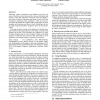Free Online Productivity Tools
i2Speak
i2Symbol
i2OCR
iTex2Img
iWeb2Print
iWeb2Shot
i2Type
iPdf2Split
iPdf2Merge
i2Bopomofo
i2Arabic
i2Style
i2Image
i2PDF
iLatex2Rtf
Sci2ools
HAPTICS
2009
IEEE
2009
IEEE
The impact of feedback design in haptic volume visualization
Enhancing volume visualization with additional cues from our sense of touch has shown the potential to increase both speed and accuracy in the data exploration. Research in the area display a wide array of modes of interaction and many of these have been evaluated to demonstrate their capabilities. There are, however, few studies performed that compare different approaches for their strengths and weaknesses and there is a lack of guidelines on how the haptic feedback should be designed to allow for best performance. This paper describes a study on the influence of the basic principle chosen for data representation on the ability to identify faint structures in the data. Three metaphors are compaired, two types of shape metaphors and one force metaphor. Based on statistical analysis on evaluation data, interviews and observations a set of guidelines on the design of haptic visualization is described.
Additional Cues | Data Exploration | HAPTICS 2009 | Human Computer Interaction | Volume Visualization |
| Added | 04 Sep 2010 |
| Updated | 04 Sep 2010 |
| Type | Conference |
| Year | 2009 |
| Where | HAPTICS |
| Authors | Karljohan E. Lundin Palmerius, Camilla Forsell |
Comments (0)

